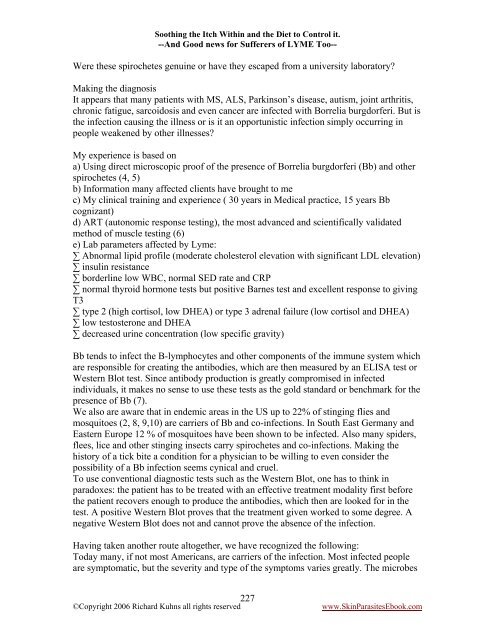Soothing the - Itchy Skin Parasites
Soothing the - Itchy Skin Parasites
Soothing the - Itchy Skin Parasites
Create successful ePaper yourself
Turn your PDF publications into a flip-book with our unique Google optimized e-Paper software.
<strong>Soothing</strong> <strong>the</strong> Itch Within and <strong>the</strong> Diet to Control it.<br />
--And Good news for Sufferers of LYME Too--<br />
Were <strong>the</strong>se spirochetes genuine or have <strong>the</strong>y escaped from a university laboratory?<br />
Making <strong>the</strong> diagnosis<br />
It appears that many patients with MS, ALS, Parkinson’s disease, autism, joint arthritis,<br />
chronic fatigue, sarcoidosis and even cancer are infected with Borrelia burgdorferi. But is<br />
<strong>the</strong> infection causing <strong>the</strong> illness or is it an opportunistic infection simply occurring in<br />
people weakened by o<strong>the</strong>r illnesses?<br />
My experience is based on<br />
a) Using direct microscopic proof of <strong>the</strong> presence of Borrelia burgdorferi (Bb) and o<strong>the</strong>r<br />
spirochetes (4, 5)<br />
b) Information many affected clients have brought to me<br />
c) My clinical training and experience ( 30 years in Medical practice, 15 years Bb<br />
cognizant)<br />
d) ART (autonomic response testing), <strong>the</strong> most advanced and scientifically validated<br />
method of muscle testing (6)<br />
e) Lab parameters affected by Lyme:<br />
∑ Abnormal lipid profile (moderate cholesterol elevation with significant LDL elevation)<br />
∑ insulin resistance<br />
∑ borderline low WBC, normal SED rate and CRP<br />
∑ normal thyroid hormone tests but positive Barnes test and excellent response to giving<br />
T3<br />
∑ type 2 (high cortisol, low DHEA) or type 3 adrenal failure (low cortisol and DHEA)<br />
∑ low testosterone and DHEA<br />
∑ decreased urine concentration (low specific gravity)<br />
Bb tends to infect <strong>the</strong> B-lymphocytes and o<strong>the</strong>r components of <strong>the</strong> immune system which<br />
are responsible for creating <strong>the</strong> antibodies, which are <strong>the</strong>n measured by an ELISA test or<br />
Western Blot test. Since antibody production is greatly compromised in infected<br />
individuals, it makes no sense to use <strong>the</strong>se tests as <strong>the</strong> gold standard or benchmark for <strong>the</strong><br />
presence of Bb (7).<br />
We also are aware that in endemic areas in <strong>the</strong> US up to 22% of stinging flies and<br />
mosquitoes (2, 8, 9,10) are carriers of Bb and co-infections. In South East Germany and<br />
Eastern Europe 12 % of mosquitoes have been shown to be infected. Also many spiders,<br />
flees, lice and o<strong>the</strong>r stinging insects carry spirochetes and co-infections. Making <strong>the</strong><br />
history of a tick bite a condition for a physician to be willing to even consider <strong>the</strong><br />
possibility of a Bb infection seems cynical and cruel.<br />
To use conventional diagnostic tests such as <strong>the</strong> Western Blot, one has to think in<br />
paradoxes: <strong>the</strong> patient has to be treated with an effective treatment modality first before<br />
<strong>the</strong> patient recovers enough to produce <strong>the</strong> antibodies, which <strong>the</strong>n are looked for in <strong>the</strong><br />
test. A positive Western Blot proves that <strong>the</strong> treatment given worked to some degree. A<br />
negative Western Blot does not and cannot prove <strong>the</strong> absence of <strong>the</strong> infection.<br />
Having taken ano<strong>the</strong>r route altoge<strong>the</strong>r, we have recognized <strong>the</strong> following:<br />
Today many, if not most Americans, are carriers of <strong>the</strong> infection. Most infected people<br />
are symptomatic, but <strong>the</strong> severity and type of <strong>the</strong> symptoms varies greatly. The microbes<br />
227<br />
©Copyright 2006 Richard Kuhns all rights reserved www.<strong>Skin</strong><strong>Parasites</strong>Ebook.com


